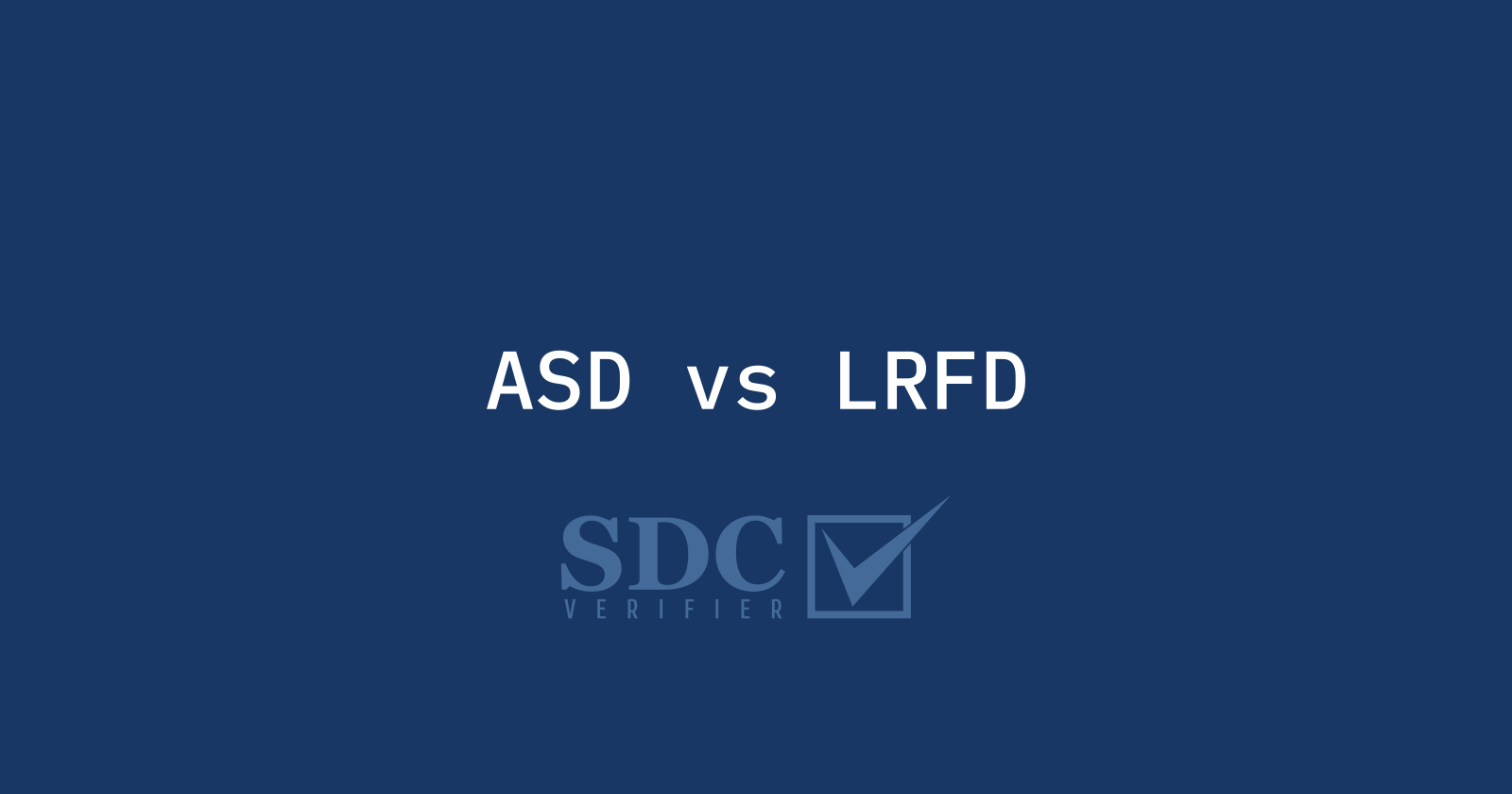Differences between ASD and LRFD methodology in finite element analysis

ASD (Allowable Stress Design) and LRFD (Load and Resistance Factor Design) methodologies are used in structural engineering to ensure the safety and reliability of structures. The ASD (or Allowable Stress, or Working Stress Design Method (WSD)) approach is one of the earliest design methodologies used in structural engineering. The design process in ASD involves calculating the applied loads on the structure and then analyzing the stresses developed within the members. The design is considered safe if the calculated stresses remain below the allowable limits. The LRFD (or Limit State Design (LSD)) approach emerged as a more rational and reliable design method later and addresses some of the limitations of the ASD approach by incorporating a probabilistic-based design philosophy. The design process in LRFD involves calculating the loads acting on the structure, determining the required strength to resist those loads, and comparing it to the available strength of the structural members. The design is considered adequate if the required strength is less than or equal to the available strength, considering appropriate safety factors. LRFD is considered a more comprehensive and accurate approach than ASD because it explicitly considers the probability of failure and incorporates reliability-based design principles. It has become the predominant design method in many countries and is supported by codes and standards.
Allowable Strength Design (ASD)
Allowable Strength Design (ASD) is based on the principle that stresses in a structure should not exceed a specific allowable value. A safety factor is applied to the expected loads and then compared to the material’s capacity. The factor of safety considers uncertainties in the material properties, loads, and other factors that could affect the strength of the structure.
The ASD methodology is often used for more straightforward, less complex structures.
Therefore, the design equation of the ASD method can be expressed as:
\[\sum\sigma_{i}\leq\sigma_{all}=\frac{\sigma_{n}}{F_{s}}\]
where σi is a working stress due to the design load, which is determined by an elastic structural analysis under the design loading conditions. σall is the allowable stress of the constructional material. The σn is the nominal stress of the material, and FS denotes the safety factor specified in the design specification.
Load and Resistance Factor Design (LRFD)
Load and Resistance Factor Design (also known as Limit State Design or Limit State Method) is based on the principle that the design of a structure should be based on the actual loads it will be subjected to, and the capacity of the material being used. In LRFD, the loads are factored up to account for uncertainties in their magnitude and distribution, while the resistance of the materials is factored down to account for uncertainties in their strength. The resulting values are then used to design the structure to safely withstand the expected loads. This approach considers both the statistical mean resistance and the statistical mean loads. The fundamental LRFD equation includes a load modifier (η), load factors (γ), force effects (Q), a resistance factor (φ), a nominal resistance (Rn), and a factored resistance (Rr = φRn)
As LRFD being a scheme of designing steel structures and structural components different from ASD, their differences can be seen by comparing the following two inequalities:
\[R_{n}/F.S. \ge \sum_{1}^{i}Q_{ni}\]
\[\phi R_{n} \ge \sum_{1}^{i}\gamma_{i}Q_{ni}\]
Where the first inequality represents the allowable stress case, and the second – the LRFD design criterion. The left side in each case is the design strength, and the right is the required strength. The term Rn defines the normal strength as given by an equation in a specification, and Qni is the load effect (i.e., a computed stress or a force such as bending moment, shear force, axial force, etc.).
ASD vs LRFD
While both methods ensure the safety and reliability of structures, they differ in their approach to design, and the factors considered in the analysis. Here are the main differences between ASD and LRFD methodologies:
- Design Philosophy. While the ASD approach ensures that the stresses under working loads do not exceed the allowable stress limits specified in the design codes, the LRFD approach involves considering the potential load effects and ensuring that the resistance of the structural elements exceeds these loads with a certain level of probability.
- Load Factors and Load Combinations. In the ASD approach, load combinations are created by adding or combining design loads in specific ways to represent different possible load scenarios. And the LRFD incorporates partial safety factors to consider uncertainties in loads. However, the load factors are applied directly to the loads rather than creating separate design loads.
- Resistance Factors and Material Strength. The ASD utilizes a single safety factor applied to the material strength to ensure that the capacity of the structural elements exceeds the applied loads. Contrarily, the LRFD employs multiple resistance factors, each associated with a different limit state. The resistance factors are derived based on statistical analyses, aiming to achieve a consistent level of reliability for different types of structures.
- Design Criteria. As for ASD, the design criteria are typically based on allowable stresses specific to different materials and provided in design codes or standards. In LRFD, the design criteria are based on limit states such as strength, serviceability, stability, and durability, representing the conditions beyond which the structure may fail to fulfill its intended function.
It’s important to note that the choice between ASD and LRFD depends on various factors, including the specific design code, project requirements, and regional practices. Design codes and standards provide guidelines for which method to use and specify the appropriate factors and criteria to be considered.

Comparison of LRFD/ASD Capacities
On a Load vs. Displacement (Stress vs. Strain) Diagram
The difference between these two methods is that the LRFD method takes into account the individual influence of the specific load (i.e., probabilistic nature of the loads) and matches it to the strength of the material. Therefore, this method is more advanced and more accurately represents the structural behavior under the loads compared to the ASD method. In the ASD methodology, only safety factors differ, as this method employs different safety factors that define (reduce) allowable stress values. That is why the LRFD method is used in most new standards and revised older ones, mainly based on the conservative ASD method. LRFD is commonly used for more complex structures, such as high-rise buildings, bridges, dams, and complex mechanisms, such as lifting appliances.
Design Checks using LRFD and ASD Methodology in SDC Verifier
One of the key features of SDC Verifier is a built-in library of industry standards, design codes, rules and regulations for structural verification in accordance with them. Standards include load sets and design checks that go with the ASD or LRFD methodology. The table below lists some of the standards with corresponding methodology
| Industry Standard | Design Methodology |
|---|---|
| API RP 2A-WSD | ASD approach |
| API RP 2A-LRFD | LRFD approach |
| DNV OS-C201-WSD | ASD approach |
| DNV OS-C101-LRFD | LRFD approach |
| DNV RP-C201 | ASD and LRFD approach |
| DVS 1612 | ASD approach |
| ISO19902 | LRFD approach |
| AISC ASD 1989 | ASD approach |
| EN 13001 | LRFD approach |
| AISC 360-10 | ASD and LRFD approach |
| F.E.M. 1.001 | ASD approach |
| DIN 15018 | ASD approach |
| ABS Plate Buckling (2004 editions), ABS Plate Buckling (2014 editions) | LRFD approach |
| ASME B31.8-2018 | LRFD approach |
| ASME VIII (Div2, 2010) | LRFD approach |
| AIJ-2017 | ASD approach |
| DNV CN30 | ASD approach |
| Eurocode 3 | LRFD approach |
| AS 3990 | ASD approach |
| Norsok N-004:2013 | LRFD approach |
| AISC 360-22 Members | LRFD approach |
| VDI 2230 | LRFD approach |
Within SDC Verifier, engineers can be confident that their models are built in accordance with industry practices and regulations. In addition, any standard can be converted to a custom for further modification to suit their needs. Using the formula editor, engineers can create standards from scratch following the ASD or LRFD philosophy.







